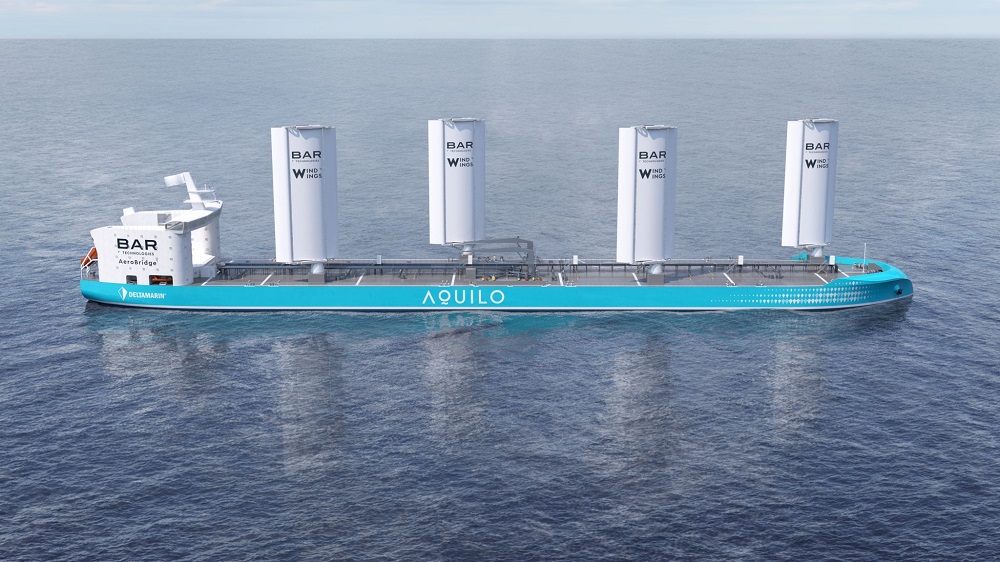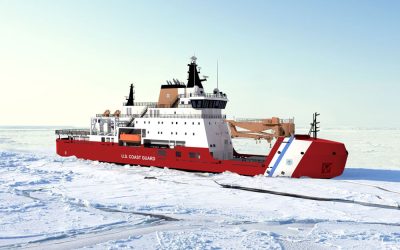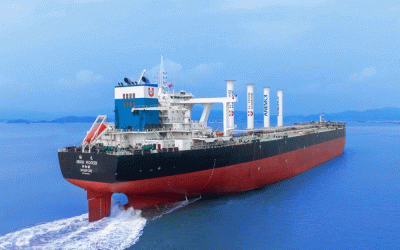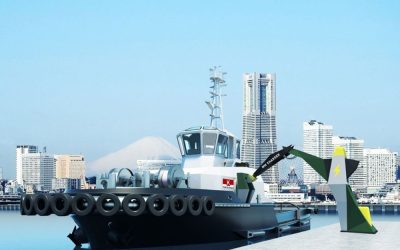In an age when environmental consciousness intersects with technological innovation, there are few more potent symbols of the maritime industry’s ambitions than the renaissance of wind assisted propulsion (WAP). Announced at an event at RINA headquarters in London on 13 February, Project Aquilo, a collaborative effort between Deltamarin and BAR Technologies, is the latest WAP endeavour hoping to stake its claim as the future of maritime transportation.
At the heart of Project Aquilo is a 15,000 dwt tanker design meticulously engineered to harness the power of wind propulsion, while optimising efficiency and performance. The DNVGL+1A class tanker has an overall length of 250m, breadth of 43.4m, depth of 22.3m and has space for 12 cargo tanks, plus two slop tanks. It has hydrodynamically optimised hull characteristics for combined sailing and engine running and is propelled by four or BAR Technologies WindWings WAP sails, each located in an aerodynamically optimised location along the hull. Additionally, the vessel design features a novel aerodynamically designed superstructure in the form of the Aero Bridge deckhouse.
Peter Kondratjeff, naval architect at Deltamarin, describes the technical intricacies of Project Aquilo, “We established our joint development project last year in 2023, with the intention to explore fuel saving potentials for a new generation of vessels and to utilise state-of-the-art software products for the optimisation process and simultaneously thinking beyond typical operational restrictions we face in our everyday work.”
Project Aquilo’s linchpin are its towering 37.5m high WindWings sails which capture wind energy and convert it into forward propulsion. Simon Schofield, CTO of BAR Technologies, whose team was part-responsible for the design elaborates, “If you look at a global route around the world, on average each of these wings will deliver about a ton and a half of fuel saving per wing per day.”
Despite their impressive size, the wings seamlessly integrate into vessel operations, folding flat during port activities. The design is based upon one of Deltamarin’s earlier projects, a long-range tanker made for another client with operational restrictions. The idea to utilise wind assisted propulsion was considered during optimisation of the hull during the design phase. BAR Technologies then advanced the process in tandem with Kondratjeff’s team. The design teams then added the specially designed superstructure, Aero Bridge, to the vessel.
“We wanted to make sure that all the design parameters are transferable to other types of ships and sizes of ships,” says Kondratjeff.
Simon Schofield, CTO of BAR Technologies, whose team was part-responsible for the design elaborates, “If you look at a global route around the world, on average each of these wings will deliver about a ton and a half of fuel saving per wing per day.”
The success of Project Aquilo has garnered attention worldwide, with multiple stakeholders expressing interest in adopting wind propulsion technologies. John Cooper, CEO of BAR Technologies notes, “We are lucky enough to have two clients in the form of Mitsubishi and Berge Bulk, and two very powerful charters in Cargill and Vale, who wholeheartedly believe what we are telling them. This is a unique situation. I think sometimes you get lucky in business but right now we’ve now got two vessels on the water and we’re able to prove the savings we are talking about,” he says.
There have been hurdles for both partners during the development process in the form of technical design choices, building trust with clients, and finding manufacturers with the right capability. However, they are confident they have now overcome these challenges. Furthermore, regulatory bodies and port authorities have shown increasing support for sustainable shipping practices, paving the way for increased adoption of WAP technology.
Both companies also benefit from a global footprint. Although based in Finland, Deltamarin is part-owned by China Merchants Group, which has signed up to supply Wind Wings to vessels in Asia. BAR Technologies has a deal with Nervion to supply its sails in Spain.
Mauri Harki, senior advisor at Deltamarin, underscores the significance of their business network, stating, “We have been working in 57 shipyards so far around the world. You can say that we are focusing on China at the moment, as it’s the biggest contractor area, but we know shipyards around the world.”
AI-assisted design
BAR Technologies’ design process focuses on cutting edge technology to create innovative solutions and think outside the box when it comes to shipbuilding. The company uses generative design techniques and Artificial Intelligence alongside more traditional CFD techniques. Schofield is keen to emphasise the company’s desire to move away from standard towing tank modelling and create new hull forms free from existing preconceptions, the hope being they will lead to unprecedented levels of efficiency.
“Traditionally, when you start one of these projects, a naval architect will sit down and develop a bunch of hulls that we start developing and testing, or they might take it a step further and you might do a parametric model, which is then used to develop a systematic variation so you can study the design. The problem with those approaches is that they’re intrinsically linked to the bias and the preconceived idea of the human that is developing that shape,” he says. This departure from traditional hull testing, leveraging advanced simulation and high-performance computing, allows for the creation of highly optimised hull designs, which the company hopes will minimise drag and maximise performance.
Schofield adds, “We now rely on a process that’s based on the latest generative design techniques and the background is very, very similar to the tools that you may use and see online to create an AI-generated image, but it’s the same process and allows us to develop whole forms without human input.”
Crew feedback on the utilisation of Wind-Wings has been overwhelmingly positive. Cooper describes the sentiment onboard the first vessel outfitted with WindWings, Newcastlemax bulker Berge Olympus, on its maiden voyage from China to Singapore and across to Brazil.
“We sent our ops director, Simon Roberts, on the vessel and it was invaluable. He really understood what worried the crew to start with, what concerned them, what they felt they needed to do to the wings, what were they thinking. And their overwhelming reaction was pride. They were very proud to have WindWings on the vessel. They were onboard a truly unique vessel when they were going down the Malacca Straits. Nobody had ever waved them from another bulker before,” he says.
Looking ahead, the momentum behind wind propulsion is expected to accelerate. With proven results and growing industry support, BAR Technologies has aspirations of dominating the wind propulsion market. As more vessels equipped with Wind-Wings grace the seas, the vision of a greener, more efficient maritime industry inches closer to reality.
The integration of Wind-Wings into Project Aquilo’s design required meticulous attention to detail and innovative thinking, but in combination the WindWings, aerodynamic superstructure and optimised hull bring collective gains of 35% in efficiency, according to Cooper. Moreover, the aerodynamic superstructure of Project Aquilo, the Aero Bridge, which features large gap for air flow, plays a pivotal role in reducing drag and further enhancing fuel efficiency. Schofield elaborates, “We started by looking at the interaction between superstructures and the wings as part of the wing development. Then we started looking at a so-called aerodynamic new superstructure and developing a new bridge just like we did with the hull. We’ve taken floor areas and accommodation spaces from the base hull and given ourselves a bit more room.”
According to Schofield, traditional superstructures are a considerable contributor to drag, which quickly became apparent when the design team started experimenting with new configurations. “By configuring these correctly, not only can we reduce drag from the wind on the ship at significant numbers of angles, but actually reduce fuel consumption,” he explains.
In addition to technical innovation, the collaborative effort from the two companies on Project Aquillo illustrates high professionalism between key industry players. Harki stresses the importance of dialogue throughout the design and construction process, stating, “At the end of the day, the shipyard is of course responsible for delivery, but clients know when they are signing the dotted line, they are making a contract with Deltamarin. We start with the customer’s outline then mediate with the shipyard. We follow the process in the shipyard, as we are doing now in several cases in China, watching carefully that all our designs are exactly done as we have written them, with no shortcuts, ” he says.
The latest in a series of pioneering wind-powered designs, Project Aquilo symbolises a paradigm shift in maritime transport, showcasing the transformative potential of wind propulsion. As more vessels equipped with WAP sails take to the seas, the industry inches closer to a viable green future where efficiency and environmental stewardship go hand in hand.




